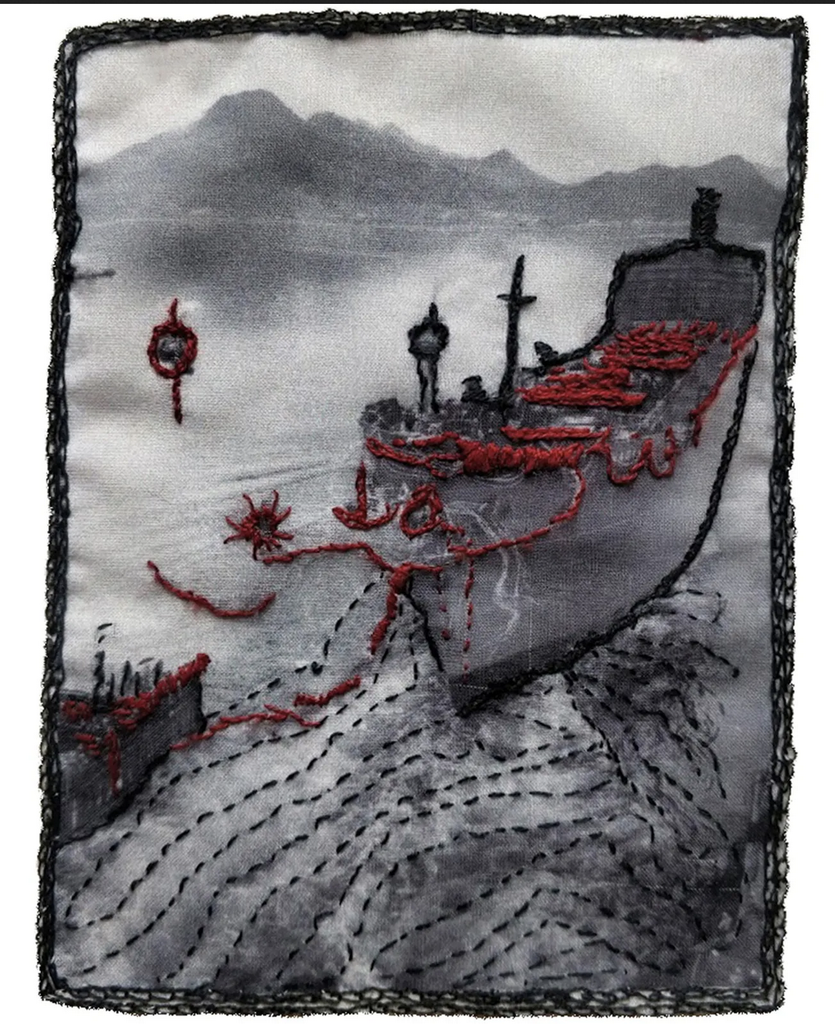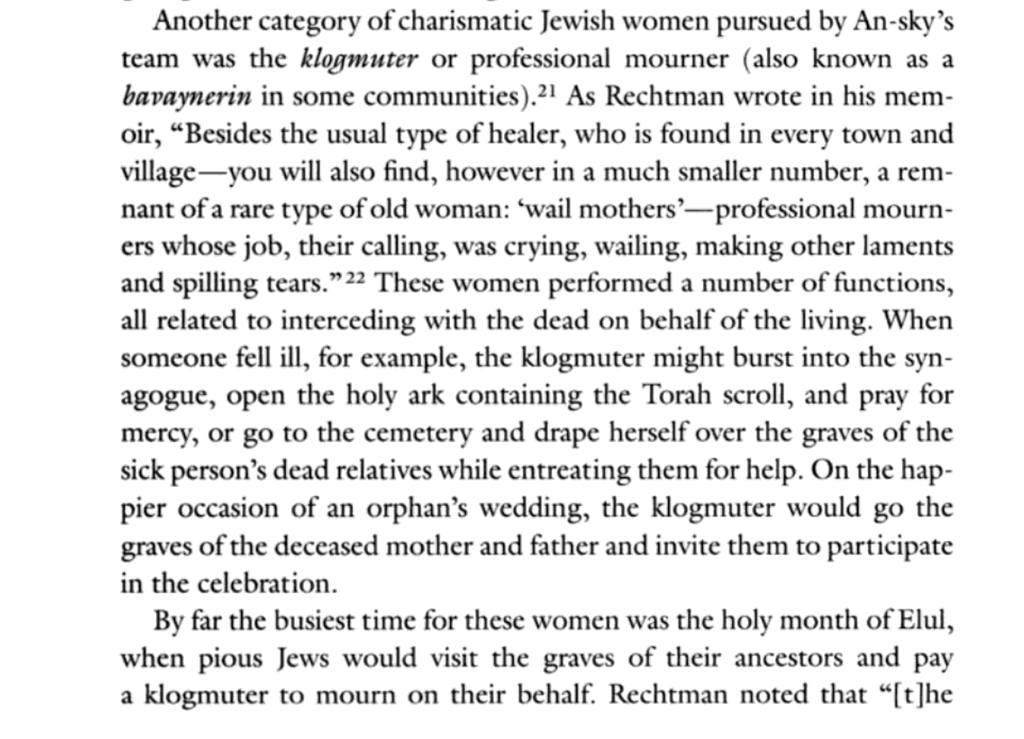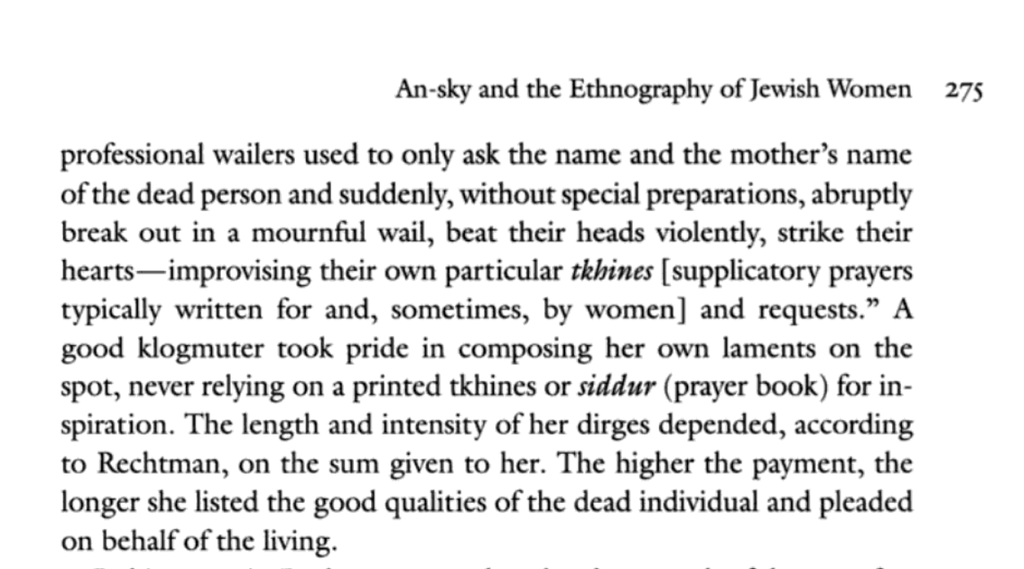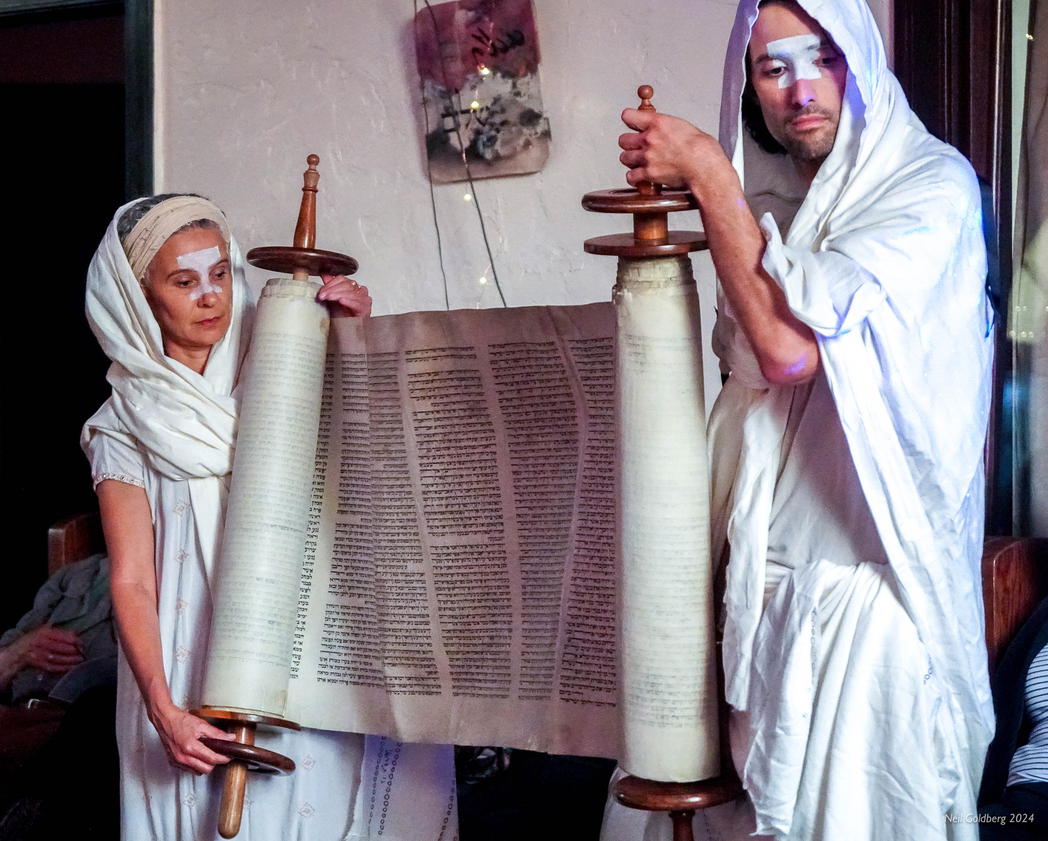(יט) כִּֽי־שְׁמַ֤עְנָה נָשִׁים֙ דְּבַר־יהוה וְתִקַּ֥ח אׇזְנְכֶ֖ם דְּבַר־פִּ֑יו וְלַמֵּ֤דְנָה בְנֽוֹתֵיכֶם֙ נֶ֔הִי וְאִשָּׁ֥ה רְעוּתָ֖הּ קִינָֽה׃
(19) Hear, O women, the word of the Eternal, let your ears receive the word of Their mouth, and teach your daughters wailing, and one another lamentation.
(טז) כֹּ֤ה אָמַר֙ יהוה צְבָא֔וֹת הִתְבּ֥וֹנְנ֛וּ וְקִרְא֥וּ לַמְקוֹנְנ֖וֹת וּתְבוֹאֶ֑ינָה וְאֶל־הַחֲכָמ֥וֹת שִׁלְח֖וּ וְתָבֽוֹאנָה׃
(16) Thus said the LORD of Hosts: Listen Summon the mikonenet, let them come; Send for the wise women, let them come.
(כה) וַיְקוֹנֵ֣ן יִרְמְיָ֘הוּ֮ עַל־יֹאשִׁיָּ֒הוּ֒ וַיֹּאמְר֣וּ כׇֽל־הַשָּׁרִ֣ים ׀ וְ֠הַשָּׁר֠וֹת בְּקִינ֨וֹתֵיהֶ֤ם עַל־יֹאשִׁיָּ֙הוּ֙ עַד־הַיּ֔וֹם וַיִּתְּנ֥וּם לְחֹ֖ק עַל־יִשְׂרָאֵ֑ל וְהִנָּ֥ם כְּתוּבִ֖ים עַל־הַקִּינֽוֹת׃
(25) Jeremiah composed laments for Josiah which all the singers, male and female, recited in their laments for Josiah, as is done to this day; they became customary in Israel and were incorporated into the laments.
(יז) וּתְמַהֵ֕רְנָה וְתִשֶּׂ֥נָה עָלֵ֖ינוּ נֶ֑הִי וְתֵרַ֤דְנָה עֵינֵ֙ינוּ֙ דִּמְעָ֔ה וְעַפְעַפֵּ֖ינוּ יִזְּלוּ־מָֽיִם׃
(17) Let them quickly start a wailing for us,That our eyes may run with tears,Our pupils flow with water.
(יט) וַתִּקַּ֨ח תָּמָ֥ר אֵ֙פֶר֙ עַל־רֹאשָׁ֔הּ וּכְתֹ֧נֶת הַפַּסִּ֛ים אֲשֶׁ֥ר עָלֶ֖יהָ קָרָ֑עָה וַתָּ֤שֶׂם יָדָהּ֙ עַל־רֹאשָׁ֔הּ וַתֵּ֥לֶךְ הָל֖וֹךְ וְזָעָֽקָה׃
(19) Tamar put ash on her head and tore the ornamented tunic she was wearing; she put her hands on her head and walked away, screaming loudly as she went.
(לז) וַתֹּ֙אמֶר֙ אֶל־אָבִ֔יהָ יֵעָ֥שֶׂה לִּ֖י הַדָּבָ֣ר הַזֶּ֑ה הַרְפֵּ֨ה מִמֶּ֜נִּי שְׁנַ֣יִם חֳדָשִׁ֗ים וְאֵֽלְכָה֙ וְיָרַדְתִּ֣י עַל־הֶהָרִ֔ים וְאֶבְכֶּה֙ עַל־בְּתוּלַ֔י אָנֹכִ֖י (ורעיתי) [וְרֵֽעוֹתָֽי]׃ (לח) וַיֹּ֣אמֶר לֵ֔כִי וַיִּשְׁלַ֥ח אוֹתָ֖הּ שְׁנֵ֣י חֳדָשִׁ֑ים וַתֵּ֤לֶךְ הִיא֙ וְרֵ֣עוֹתֶ֔יהָ וַתֵּ֥בְךְּ עַל־בְּתוּלֶ֖יהָ עַל־הֶֽהָרִֽים׃ (לט) וַיְהִ֞י מִקֵּ֣ץ ׀ שְׁנַ֣יִם חֳדָשִׁ֗ים וַתָּ֙שׇׁב֙ אֶל־אָבִ֔יהָ וַיַּ֣עַשׂ לָ֔הּ אֶת־נִדְר֖וֹ אֲשֶׁ֣ר נָדָ֑ר וְהִיא֙ לֹא־יָדְעָ֣ה אִ֔ישׁ וַתְּהִי־חֹ֖ק בְּיִשְׂרָאֵֽל׃ (מ) מִיָּמִ֣ים ׀ יָמִ֗ימָה תֵּלַ֙כְנָה֙ בְּנ֣וֹת יִשְׂרָאֵ֔ל לְתַנּ֕וֹת לְבַת־יִפְתָּ֖ח הַגִּלְעָדִ֑י אַרְבַּ֥עַת יָמִ֖ים בַּשָּׁנָֽה׃ {פ}
(37) She further said to her father, “Let this be done for me: let me be for two months, and I will go with my companions and lament upon the hills and there bewail my maidenhood.” (38) “Go,” he replied. He let her go for two months, and she and her companions went and bewailed her maidenhood upon the hills. (39) After two months’ time, she returned to her father, and he did to her as he had vowed. She had never known a man. So it became a custom in Israel (40) for the daughters of Israel to go every year, for four days in the year, and chant dirges for the daughter of Jephthah the Gileadite.
(טו) כֹּ֣ה ׀ אָמַ֣ר יהוה ק֣וֹל בְּרָמָ֤ה נִשְׁמָע֙ נְהִי֙ בְּכִ֣י תַמְרוּרִ֔ים רָחֵ֖ל מְבַכָּ֣ה עַל־בָּנֶ֑יהָ מֵאֲנָ֛ה לְהִנָּחֵ֥ם עַל־בָּנֶ֖יהָ כִּ֥י אֵינֶֽנּוּ׃ {ס}
(15) Thus said the Divine: A cry is heard on high-- wailing, bitter weeping—Rachel weeping for her children. She refuses to be comforted for her children, who are gone.
(טז) קִינָ֥ה הִיא֙ וְק֣וֹנְנ֔וּהָ בְּנ֥וֹת הַגּוֹיִ֖ם תְּקוֹנֵ֣נָּה אוֹתָ֑הּ עַל־מִצְרַ֤יִם וְעַל־כׇּל־הֲמוֹנָהּ֙ תְּקוֹנֵ֣נָּה אוֹתָ֔הּ נְאֻ֖ם אדני יהוה׃ {פ}
(16) This is a dirge, and it shall be intoned;The women of the nations shall intone it,They shall intone it over Egypt and all her multitude—declares the Lord GOD.

(ד) ... רַבִּי יְהוּדָה אוֹמֵר, אֲפִלּוּ עָנִי שֶׁבְּיִשְׂרָאֵל, לֹא יִפְחֹת מִשְּׁנֵי חֲלִילִים וּמְקוֹנָנֶת:
(4)...Rabbi Yehuda says: Even the poorest man of the Jewish people may not provide fewer than two flutes and a lamenting woman, which it was customary to hire for a funeral, as these too are included in the duties of burial.
מַתְנִי׳ נָשִׁים בַּמּוֹעֵד מְעַנּוֹת אֲבָל לֹא מְטַפְּחוֹת רַבִּי יִשְׁמָעֵאל אוֹמֵר הַסְּמוּכוֹת לַמִּטָּה מְטַפְּחוֹת בְּרָאשֵׁי חֳדָשִׁים בַּחֲנוּכָּה וּבְפוּרִים מְעַנּוֹת וּמְטַפְּחוֹת בְּזֶה וָזֶה לֹא מְקוֹנְנוֹת נִקְבַּר הַמֵּת לֹא מְעַנּוֹת וְלֹא מְטַפְּחוֹת אֵיזֶהוּ עִינּוּי שֶׁכּוּלָּן עוֹנוֹת כְּאַחַת קִינָה שֶׁאַחַת מְדַבֶּרֶת וְכוּלָּן עוֹנוֹת אַחֲרֶיהָ שֶׁנֶּאֱמַר וְלַמֵּדְנָה בְנוֹתֵיכֶם נֶהִי וְאִשָּׁה רְעוּתָהּ קִינָה אֲבָל לֶעָתִיד לָבֹא הוּא אוֹמֵר בִּלַּע הַמָּוֶת לָנֶצַח וּמָחָה יהוה אֱלֹהִים דִּמְעָה מֵעַל כׇּל פָּנִים וְגוֹ׳: גְּמָ׳ מַאי אֲמַרַן אָמַר רַב וַיהוה לְאָזְלָא וַיהוה לַחֲבִילָא אָמַר רָבָא נְשֵׁי דְּשַׁכְנְצִיב אֲמַרַן הָכִי וַיהוה לָאָזְלָא וַיהוה לַחֲבִילָא וְאָמַר רָבָא נְשֵׁי דְשַׁכְנְצִיב אָמְרָן גּוּד גַּרְמָא מִכַּכָּא וְנִמְטֵי מַיָּא לְאַנְטִיכִי וְאָמַר רָבָא נְשֵׁי דְשַׁכְנְצִיב אָמְרָן עֲטוֹף וְכַסּוֹ טוּרֵי דְּבַר רָמֵי וּבַר רַבְרְבֵי הוּא וְאָמַר רָבָא נְשֵׁי דְשַׁכְנְצִיב אָמְרָן שְׁייוֹל אִצְטְלָא דְמֵלָתָא לְבַר חוֹרִין דִּשְׁלִימוּ זְווֹדֵיהּ וְאָמַר רָבָא נְשֵׁי דְשַׁכְנְצִיב אָמְרָן רָהֵיט וְנָפֵיל אַמַּעְבָּרָא וִיזוּפְתָּא יָזֵיף וְאָמַר רָבָא נְשֵׁי דְשַׁכְנְצִיב אָמְרָן אֲחַנָא תַּגָּרֵי אַזַּבְזָגֵי מִיבַּדְקוּ וְאָמַר רָבָא נְשֵׁי דְשַׁכְנְצִיב אָמְרָן מוֹתָא כִּי מוֹתָא וּמַרְעִין חִיבוּלְיָא ...
MISHNA:On the intermediate days of a Festival women may wail in grief over the deceased, but they may not clap [metapeḥot] their hands in mourning. Rabbi Yishmael says: Those who are close to the bier may clap.On New Moons, Hanukkah and Purim, which are not Festivals by Torah law, the women may both wail and clap their hands in mourning. On both the intermediate days of a Festival and on New Moons, Hanukkah and Purim they may not lament. After the deceased has been buried they may neither wail nor clap. The mishna explains: What is considered wailing? This is when they all wail together simultaneously. And what is considered a lament? This is when one speaks and they all answer after her with a repeated refrain, as it is stated: “And teach your daughters wailing and everyone her neighbor lamentation” (Jeremiah 9:19). In order to conclude on a positive note, the mishna says: But with regard to the future, the verse states: “He will destroy death forever; and the Lord, God, will wipe away tears from off all faces and the reproach of His people He will take away from off all the earth” (Isaiah 25:8). GEMARA:What do the women who wail over the dead say? Rav said: They say:Woe for the one who leaves, woe for the one who remains.Rava said: The women in the city of Shekhantziv, who were known for their wisdom, would say as follows: Woe for the one who leaves, woe for the one who remains. And Rava said: The women of Shekhantziv would say: The bone falls from the jaw and the water returns to the kettle.And Rava said: The women of Shekhantziv would say: Shroud and cover the mountains for this is a sacred thing, they ie the deceased were the child of mighty ones. Rava said: The women of Shekhantziv would say: Removethe cloak of the matterfor a free person whose provisions have been completed.And Rava said: The women of Shekhantziv would say:A person runs and tumbles to the ferry and still they have to borrows a coin for the ferry across to the spirit world. And Rava said:The women of Shekhantziv would say: Our brothers, the merchants, will be examined at their places of business to see if they are honest businessmen.And Rava said: The women of Shekhantziv would say: Death is like death, as everyone must die, and suffering is like interest....


You can listen and learn the tune here. https://shorturl.at/4t8sO )




